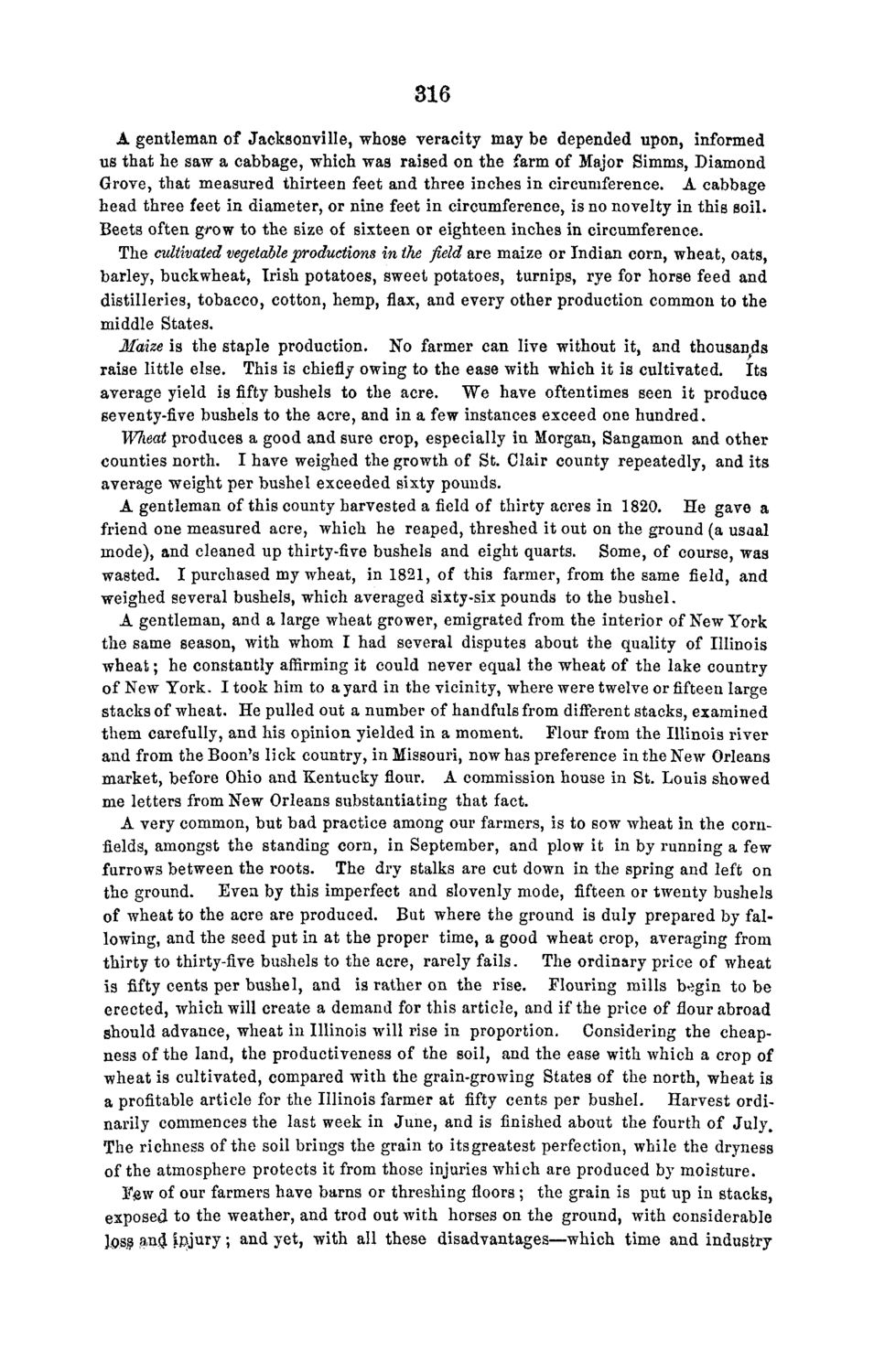| |
| |
Caption: Board of Trustees Minutes - 1868
This is a reduced-resolution page image for fast online browsing.

EXTRACTED TEXT FROM PAGE:
316 A gentleman of Jacksonville, whose veracity may be depended upon, informed us that he saw a cabbage, which was raised on the farm of Major Simms, Diamond Grove, that measured thirteen feet and three inches in circumference. A cabbage head three feet in diameter, or nine feet in circumference, is no novelty in this soil. Beets often grow to the size of sixteen or eighteen inches in circumference. The cultivated vegetable productions in the field are maize or Indian corn, wheat, oats, barley, buckwheat, Irish potatoes, sweet potatoes, turnips, rye for horse feed and distilleries, tobacco, cotton, hemp, flax, and every other production common to the middle States. Maize is the staple production. No farmer can live without it, and thousands raise little else. This is chiefly owing to the ease with which it is cultivated. Its average yield is fifty bushels to the acre. We have oftentimes seen it produce seventy-five bushels to the acre, and in a few instances exceed one hundred. Wlieat produces a good and sure crop, especially in Morgan, Sangamon and other counties north. I have weighed the growth of St. Clair county repeatedly, and its average weight per bushel exceeded sixty pounds. A gentleman of this county harvested a field of thirty acres in 1820. He gave a friend one measured acre, which he reaped, threshed it out on the ground (a usual mode), and cleaned up thirty-five bushels and eight quarts. Some, of course, was wasted. I purchased my wheat, in 1821, of this farmer, from the same field, and weighed several bushels, which averaged sixty-six pounds to the bushel. A gentleman, and a large wheat grower, emigrated from the interior of New York the same season, with whom I had several disputes about the quality of Illinois wheat; he constantly affirming it could never equal the wheat of the lake country of New York. I took him to a yard in the vicinity, where were twelve or fifteen large stacks of wheat. He pulled out a number of handfuls from different stacks, examined them carefully, and his opinion yielded in a moment. Flour from the Illinois river and from the Boon's lick country, in Missouri, now has preference in the New Orleans market, before Ohio and Kentucky flour. A commission house in St. Louis showed me letters from New Orleans substantiating that fact. A very common, but bad practice among our farmers, is to sow wheat in the cornfields, amongst the standing corn, in September, and plow it in by running a few furrows between the roots. The dry stalks are cut down in the spring and left on the ground. Even by this imperfect and slovenly mode, fifteen or twenty bushels of wheat to the acre are produced. But where the ground is duly prepared by fallowing, and the seed put in at the proper time, a good wheat crop, averaging from thirty to thirty-five bushels to the acre, rarely fails. The ordinary price of wheat is fifty cents per bushel, and is rather on the rise. Flouring mills begin to be erected, which will create a demand for this article, and if the price of flour abroad should advance, wheat in Illinois will rise in proportion. Considering the cheapness of the land, the productiveness of the soil, and the ease with which a crop of wheat is cultivated, compared with the grain-growing States of the north, wheat is a profitable article for the Illinois farmer at fifty cents per bushel. Harvest ordinarily commences the last week in June, and is finished about the fourth of July. The richness of the soil brings the grain to its greatest perfection, while the dryness of the atmosphere protects it from those injuries which are produced by moisture. F#w of our farmers have barns or threshing floors ; the grain is put up in stacks, exposed to the weather, and trod out with horses on the ground, with considerable loss an.(J Injury; and yet, with all these disadvantages—which time and industry
| |